The Retina Nebula is a bipolar planetary nebula located in the southern constellation Lupus. It has an apparent magnitude of 11 and lies approximately 2,000 light-years away. It is catalogued as IC 4406 in the Index Catalogue.
Like all planetary nebulae, IC 4406 was formed when an evolved star reached the end of its life cycle and expelled its outer layers into space. The hot stellar remnant illuminates the nebula as the expanding dust clouds gradually move away from it. The nebula will eventually disappear into the surrounding space. In a few million years, all that will be left of it will be a fading white dwarf.
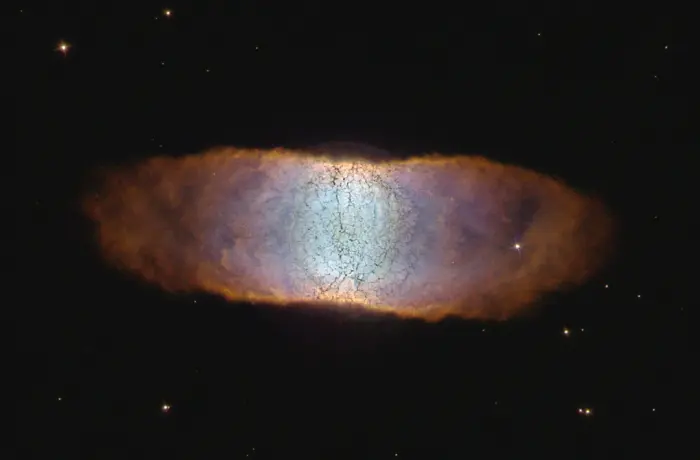
The Hubble telescope reveals a rainbow of colors in this dying star, called IC 4406. Like many other so-called planetary nebulae, IC 4406 exhibits a high degree of symmetry. The nebula’s left and right halves are nearly mirror images of the other. If we could fly around IC 4406 in a spaceship, we would see that the gas and dust form a vast donut of material streaming outward from the dying star. We don’t see the donut shape in this photograph because we are viewing IC 4406 from the Earth-orbiting Hubble telescope. From this vantage point, we are seeing the side of the donut. This side view allows us to see the intricate tendrils of material that have been compared to the eye’s retina. In fact, IC 4406 is dubbed the “Retina Nebula.” This image is a composite of data taken by Hubble’s Wide Field Planetary Camera 2 in June 2001 by Bob O’Dell (Vanderbilt University) and collaborators and in January 2002 by The Hubble Heritage Team (STScI). Filters used to create this color image show oxygen, hydrogen, and nitrogen gas glowing in this object. Image credit: NASA and The Hubble Heritage Team (STScI/AURA); acknowledgment: C.R. O’Dell (Vanderbilt University)
The Retina Nebula appears symmetrical, which is a common feature of planetary nebulae. The nebula’s left and right sides appear almost like mirror images of each other. The nebula’s diameter across the short dimension is 0.25 light-years, while the long dimension is 3.6 times as large.
The nebula appears rectangular because we see it from its side. Its true shape is that of a torus or prolate spheroid. The nebula’s dust and gas form a large doughnut of material that expands away from the central star. The nebula itself is likely a hollow cylinder. The image taken with the Spitzer Space Telescope in 2012 revealed the nebula’s rectangular structure in infrared light.
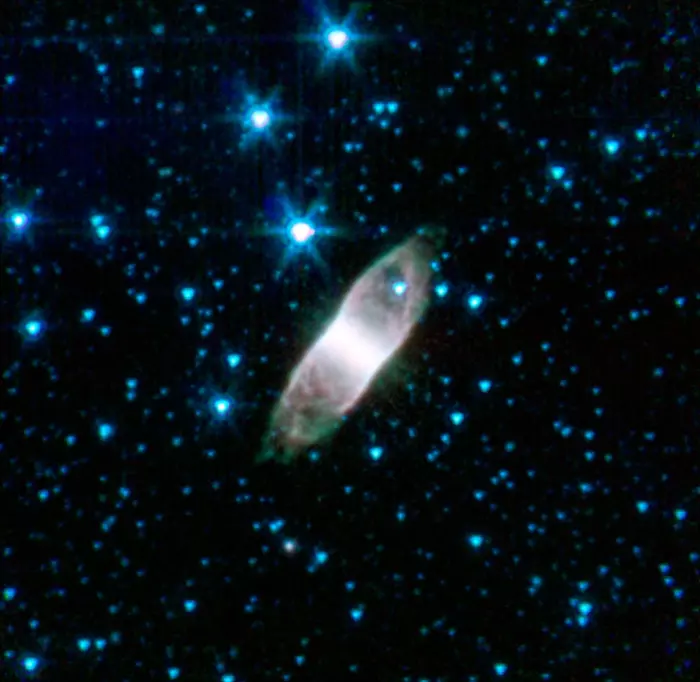
This boxy, almost rectangular structure, known as the Retina Nebula or IC 4406, shows its infrared glow in this image from NASA’s Spitzer Space Telescope. Credit: NASA/JPL-Caltech
The thick clouds of nebular material confine the powerful radiation from the central star. The star’s light ionizes the material inside the clouds and causes it to glow.
Seen from the side, the tendrils of dust that streak across the central portion of the nebula form a pattern reminiscent of the human eye’s retina. The name Retina Nebula was first suggested by Robert F. Coker of the University of Leeds.
The dark lanes across the centre span about 160 astronomical units (Earth-Sun distances). They lie at the border between the neutral gas and the hot glowing gas visible in images of the nebula. The dark dust lanes are a thousand times denser than the rest of the nebula.
The central star, HD 125720, has a spectrum similar to that of a Wolf-Rayet star. A 2021 study that used data from the Gaia Early Data Release 3 (EDR3) suggested that the star may be part of a binary system. It is faint and appears against nebulosity with high surface brightness.
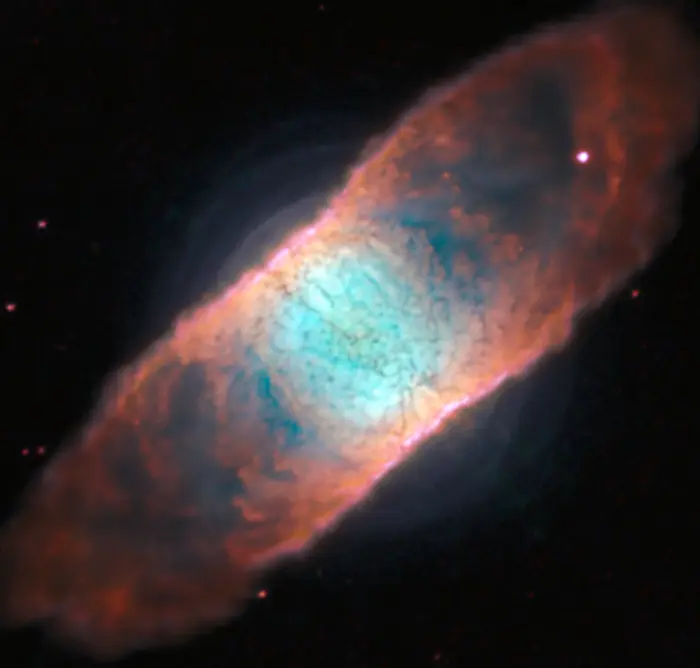
The coupling of the AOF with MUSE gives access to both greater sharpness and a wide dynamic range when observing celestial objects like planetary nebulae. These new observations of IC 4406 revealed shells that have never been seen before, along with the already familiar dark dust structures in the nebula that gave it the popular name the Retina Nebula. This image shows a small fraction of the total data collected by the MUSE using the AOF system and demonstrates the increased abilities of the new AOF equipped MUSE instrument. Image credit: ESO/J. Richard (CRAL) (CC BY 4.0)
The better-known Ring Nebula (Messier 57) in the constellation Lyra has a similar shape to IC 4406 but appears very different to us because we see the doughnut of nebular material from the top. The Dumbbell Nebula (Messier 27) in Vulpecula and the Helix Nebula (NGC 7293) in Aquarius have also been described as prolate spheroids. These nebulae are similar to bipolar objects because they appear to have density concentrations near their equatorial planes.
The image of the Retina Nebula taken with the Wide Field Planetary Camera 2 on NASA’s Hubble Space Telescope in 2001 and 2002 shows the light from the oxygen atoms as blue, hydrogen as green, and nitrogen as red. The final image shows the distribution and concentration of the three gases in IC 4406. The neutral gas in the nebula that does not emit visible light can be detected by radio telescopes.
The Retina Nebula was first photographed by Hubble in 1997. The image was part of the Hubble Gallery of Planetary Nebulae, which also included images of the Twin Jet Nebula (Minkowski’s Butterfly) in the constellation Ophiuchus, the Lemon Slice Nebula (IC 3568) in Camelopardalis, the Blinking Planetary Nebula (NGC 6826) in Cygnus, the Blue Planetary (NGC 3918) in Centaurus, and the Saturn Nebula (NGC 7009) in Aquarius.
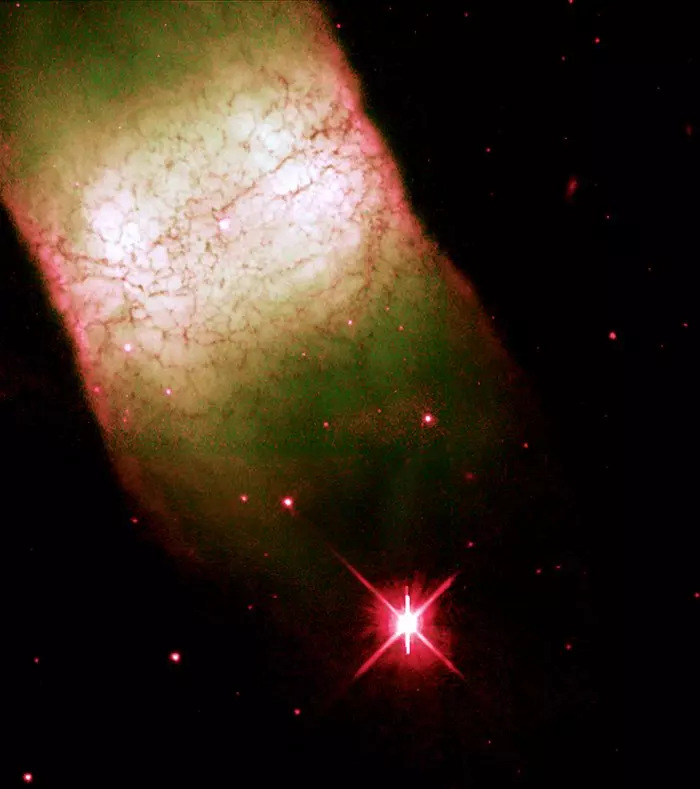
The 1997 image of the Retina Nebula taken with the Hubble Space Telescope. Image credit: Howard Bond (STScI) and NASA/ESA
Location
The Retina Nebula lies in the western part of Lupus, near the border with Centaurus. It appears near the blue giant star Alpha Lupi (mag. 2.30), the brightest star in Lupus, and can be found about a third of the way from Eta Centauri (mag. 2.35) to Zeta Centauri (mag. 2.55).
At the declination -44°09’, the Retina Nebula is mostly invisible to observers in the mid-northern latitudes. It is visible from locations south of the latitude 45° N but may not rise very high above the horizon for most northern observers.
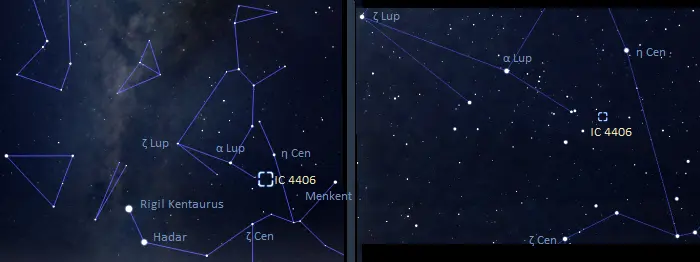
The location of the Retina Nebula, image: Stellarium
The best time of the year to observe the Retina Nebula and other deep sky objects in Lupus is during the month of June, when the constellation rises higher above the horizon in the evening.
Retina Nebula – NGC 4406
| Constellation | Lupus |
| Right ascension | 14h 22m 26.1440976888s |
| Declination | −44° 09′ 02.185112988″ |
| Apparent size | 0.51975501 x 0.51887000 (Rad) |
| Apparent magnitude | 11 |
| Absolute magnitude | -0.3 |
| Distance | 2,000 light-years (600 parsecs) |
| Names and designations | Retina Nebula, IC 4406, ESO 272-6, Hen 2-110, AM 1419-435, IRAS 14192-4355, PK 319+15 1, PMN J1422-4409, PN G319.6+15.7, Sa 2-105, StWr 4-12, VV 69, VV’ 120, ARO 517, PSCz P14192-4355, SCM 84, WRAY 16-153, Gaia DR2 6102472263541814272, Gaia DR3 6102472263541814272 |